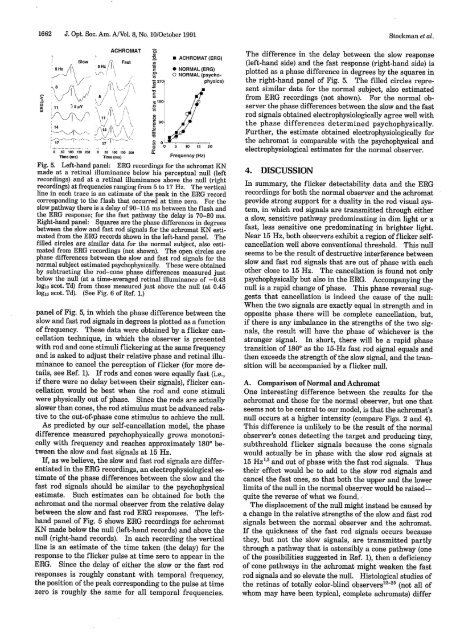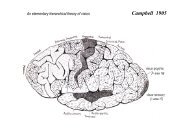Slow and fast pathways in the human rod visual system - CVRL main
Slow and fast pathways in the human rod visual system - CVRL main
Slow and fast pathways in the human rod visual system - CVRL main
You also want an ePaper? Increase the reach of your titles
YUMPU automatically turns print PDFs into web optimized ePapers that Google loves.
1662 J. Opt. Soc. Am. A/Vol. 8, No. 10/October 1991ACHROMAT 'aIZ x+ <strong>Slow</strong> Fast X:5Hz 5Hz c NORMALW8~~~~~5 pV~~~~~~~~~~~~~~N,,- m \ ,.ACHROMAT (ERG)(ERG)0 NORMAL (psycho-,270- physics)17 ~~170i, 0 5 10 15 20so i 1550 200 0 so 100150 200 0 FTime (ms) Time (ms)Frequency (Hz)Fig. 5. Left-h<strong>and</strong> panel: ERG record<strong>in</strong>gs for <strong>the</strong> achromat KNmade at a ret<strong>in</strong>al illum<strong>in</strong>ance below his perceptual null (leftrecord<strong>in</strong>gs) <strong>and</strong> at a ret<strong>in</strong>al illum<strong>in</strong>ance above <strong>the</strong> null (rightrecord<strong>in</strong>gs) at frequencies rang<strong>in</strong>g from 5 to 17 Hz. The verticall<strong>in</strong>e <strong>in</strong> each trace is an estimate of <strong>the</strong> peak <strong>in</strong> <strong>the</strong> ERG recordcorrespond<strong>in</strong>g to <strong>the</strong> flash that occurred at time zero. For <strong>the</strong>slow pathway <strong>the</strong>re is a delay of 90-115 ms between <strong>the</strong> flash <strong>and</strong><strong>the</strong> ERG response; for <strong>the</strong> <strong>fast</strong> pathway <strong>the</strong> delay is 70-80 ms.Right-h<strong>and</strong> panel: Squares are <strong>the</strong> phase differences <strong>in</strong> degreesbetween <strong>the</strong> slow <strong>and</strong> <strong>fast</strong> <strong>rod</strong> signals for <strong>the</strong> achromat KN estimatedfrom <strong>the</strong> ERG records shown <strong>in</strong> <strong>the</strong> left-h<strong>and</strong> panel. Thefilled circles are similar data for <strong>the</strong> normal subject, also estimatedfrom ERG record<strong>in</strong>gs (not shown). The open circles arephase differences between <strong>the</strong> slow <strong>and</strong> <strong>fast</strong> <strong>rod</strong> signals for <strong>the</strong>normal subject estimated psychophysically. These were obta<strong>in</strong>edby subtract<strong>in</strong>g <strong>the</strong> <strong>rod</strong>-cone phase differences measured justbelow <strong>the</strong> null (at a time-averaged ret<strong>in</strong>al illum<strong>in</strong>ance of -0.43logio scot. Td) from those measured just above <strong>the</strong> null (at 0.45logio scot. Td). (See Fig. 6 of Ref. 1.)panel of Fig. 5, <strong>in</strong> which <strong>the</strong> phase difference between <strong>the</strong>slow <strong>and</strong> <strong>fast</strong> <strong>rod</strong> signals <strong>in</strong> degrees is plotted as a functionof frequency. These data were obta<strong>in</strong>ed by a flicker cancellationtechnique, <strong>in</strong> which <strong>the</strong> observer is presentedwith <strong>rod</strong> <strong>and</strong> cone stimuli flicker<strong>in</strong>g at <strong>the</strong> same frequency<strong>and</strong> is asked to adjust <strong>the</strong>ir relative phase <strong>and</strong> ret<strong>in</strong>al illum<strong>in</strong>anceto cancel <strong>the</strong> perception of flicker (for more details,see Ref. 1). If <strong>rod</strong>s <strong>and</strong> cones were equally <strong>fast</strong> (i.e.,if <strong>the</strong>re were no delay between <strong>the</strong>ir signals), flicker cancellationwould be best when <strong>the</strong> <strong>rod</strong> <strong>and</strong> cone stimuliwere physically out of phase. S<strong>in</strong>ce <strong>the</strong> <strong>rod</strong>s are actuallyslower than cones, <strong>the</strong> <strong>rod</strong> stimulus must be advanced relativeto <strong>the</strong> out-of-phase cone stimulus to achieve <strong>the</strong> null.As predicted by our self-cancellation model, <strong>the</strong> phasedifference measured psychophysically grows monotonicallywith frequency <strong>and</strong> reaches approximately 1800 between<strong>the</strong> slow <strong>and</strong> <strong>fast</strong> signals at 15 Hz.If, as we believe, <strong>the</strong> slow <strong>and</strong> <strong>fast</strong> <strong>rod</strong> signals are differentiated<strong>in</strong> <strong>the</strong> ERG record<strong>in</strong>gs, an electrophysiological estimateof <strong>the</strong> phase differences between <strong>the</strong> slow <strong>and</strong> <strong>the</strong><strong>fast</strong> <strong>rod</strong> signals should be similar to <strong>the</strong> psychophysicalestimate. Such estimates can be obta<strong>in</strong>ed for both <strong>the</strong>achromat <strong>and</strong> <strong>the</strong> normal observer from <strong>the</strong> relative delaybetween <strong>the</strong> slow <strong>and</strong> <strong>fast</strong> <strong>rod</strong> ERG responses. The lefth<strong>and</strong>panel of Fig. 5 shows ERG record<strong>in</strong>gs for achromatKN made below <strong>the</strong> null (left-h<strong>and</strong> records) <strong>and</strong> above <strong>the</strong>null (right-h<strong>and</strong> records). In each record<strong>in</strong>g <strong>the</strong> verticall<strong>in</strong>e is an estimate of <strong>the</strong> time taken (<strong>the</strong> delay) for <strong>the</strong>response to <strong>the</strong> flicker pulse at time zero to appear <strong>in</strong> <strong>the</strong>ERG. S<strong>in</strong>ce <strong>the</strong> delay of ei<strong>the</strong>r <strong>the</strong> slow or <strong>the</strong> <strong>fast</strong> <strong>rod</strong>responses is roughly constant with temporal frequency,<strong>the</strong> position of <strong>the</strong> peak correspond<strong>in</strong>g to <strong>the</strong> pulse at timezero is roughly <strong>the</strong> same for all temporal frequencies.The difference <strong>in</strong> <strong>the</strong> delay between <strong>the</strong> slow response(left-h<strong>and</strong> side) <strong>and</strong> <strong>the</strong> <strong>fast</strong> response (right-h<strong>and</strong> side) isplotted as a phase difference <strong>in</strong> degrees by <strong>the</strong> squares <strong>in</strong><strong>the</strong> right-h<strong>and</strong> panel of Fig. 5. The filled circles representsimilar data for <strong>the</strong> normal subject, also estimatedfrom ERG record<strong>in</strong>gs (not shown). For <strong>the</strong> normal observer<strong>the</strong> phase differences between <strong>the</strong> slow <strong>and</strong> <strong>the</strong> <strong>fast</strong><strong>rod</strong> signals obta<strong>in</strong>ed electrophysiologically agree well with<strong>the</strong> phase differences determ<strong>in</strong>ed psychophysically.Fur<strong>the</strong>r, <strong>the</strong> estimate obta<strong>in</strong>ed electrophysiologically for<strong>the</strong> achromat is comparable with <strong>the</strong> psychophysical <strong>and</strong>electrophysiological estimates for <strong>the</strong> normal observer.4. DISCUSSIONStockman et al.In summary, <strong>the</strong> flicker detectability data <strong>and</strong> <strong>the</strong> ERGrecord<strong>in</strong>gs for both <strong>the</strong> normal observer <strong>and</strong> <strong>the</strong> achromatprovide strong support for a duality <strong>in</strong> <strong>the</strong> <strong>rod</strong> <strong>visual</strong> <strong>system</strong>,<strong>in</strong> which <strong>rod</strong> signals are transmitted through ei<strong>the</strong>ra slow, sensitive pathway predom<strong>in</strong>at<strong>in</strong>g <strong>in</strong> dim light or a<strong>fast</strong>, less sensitive one predom<strong>in</strong>at<strong>in</strong>g <strong>in</strong> brighter light.Near 15 Hz, both observers exhibit a region of flicker selfcancellationwell above conventional threshold. This nullseems to be <strong>the</strong> result of destructive <strong>in</strong>terference betweenslow <strong>and</strong> <strong>fast</strong> <strong>rod</strong> signals that are out of phase with eacho<strong>the</strong>r close to 15 Hz. The cancellation is found not onlypsychophysically but also <strong>in</strong> <strong>the</strong> ERG. Accompany<strong>in</strong>g <strong>the</strong>null is a rapid change of phase. This phase reversal suggeststhat cancellation is <strong>in</strong>deed <strong>the</strong> cause of <strong>the</strong> null:When <strong>the</strong> two signals are exactly equal <strong>in</strong> strength <strong>and</strong> <strong>in</strong>opposite phase <strong>the</strong>re will be complete cancellation, but,if <strong>the</strong>re is any imbalance <strong>in</strong> <strong>the</strong> strengths of <strong>the</strong> two signals,<strong>the</strong> result will have <strong>the</strong> phase of whichever is <strong>the</strong>stronger signal. In short, <strong>the</strong>re will be a rapid phasetransition of 180° as <strong>the</strong> 15-Hz <strong>fast</strong> <strong>rod</strong> signal equals <strong>and</strong><strong>the</strong>n exceeds <strong>the</strong> strength of <strong>the</strong> slow signal, <strong>and</strong> <strong>the</strong> transitionwill be accompanied by a flicker null.A. Comparison of Normal <strong>and</strong> AchromatOne <strong>in</strong>terest<strong>in</strong>g difference between <strong>the</strong> results for <strong>the</strong>achromat <strong>and</strong> those for <strong>the</strong> normal observer, but one thatseems not to be central to our model, is that <strong>the</strong> achromat'snull occurs at a higher <strong>in</strong>tensity (compare Figs. 2 <strong>and</strong> 4).This difference is unlikely to be <strong>the</strong> result of <strong>the</strong> normalobserver's cones detect<strong>in</strong>g <strong>the</strong> target <strong>and</strong> p<strong>rod</strong>uc<strong>in</strong>g t<strong>in</strong>y,subthreshold flicker signals because <strong>the</strong> cone signalswould actually be <strong>in</strong> phase with <strong>the</strong> slow <strong>rod</strong> signals at15 Hz", 3 <strong>and</strong> out of phase with <strong>the</strong> <strong>fast</strong> <strong>rod</strong> signals. Thus<strong>the</strong>ir effect would be to add to <strong>the</strong> slow <strong>rod</strong> signals <strong>and</strong>cancel <strong>the</strong> <strong>fast</strong> ones, so that both <strong>the</strong> upper <strong>and</strong> <strong>the</strong> lowerlimits of <strong>the</strong> null <strong>in</strong> <strong>the</strong> normal observer would be raisedquite<strong>the</strong> reverse of what we found..The displacement of <strong>the</strong> null might <strong>in</strong>stead be caused bya change <strong>in</strong> <strong>the</strong> relative strengths of <strong>the</strong> slow <strong>and</strong> <strong>fast</strong> <strong>rod</strong>signals between <strong>the</strong> normal observer <strong>and</strong> <strong>the</strong> achromat.If <strong>the</strong> quickness of <strong>the</strong> <strong>fast</strong> <strong>rod</strong> signals occurs because<strong>the</strong>y, but not <strong>the</strong> slow signals, are transmitted partlythrough a pathway that is ostensibly a cone pathway (oneof <strong>the</strong> possibilities suggested <strong>in</strong> Ref. 1), <strong>the</strong>n a deficiencyof cone <strong>pathways</strong> <strong>in</strong> <strong>the</strong> achromat might weaken <strong>the</strong> <strong>fast</strong><strong>rod</strong> signals <strong>and</strong> so elevate <strong>the</strong> null. Histological studies of<strong>the</strong> ret<strong>in</strong>as of totally color-bl<strong>in</strong>d observers 2 2 - 2 5 (not all ofwhom may have been typical, complete achromats) differ










